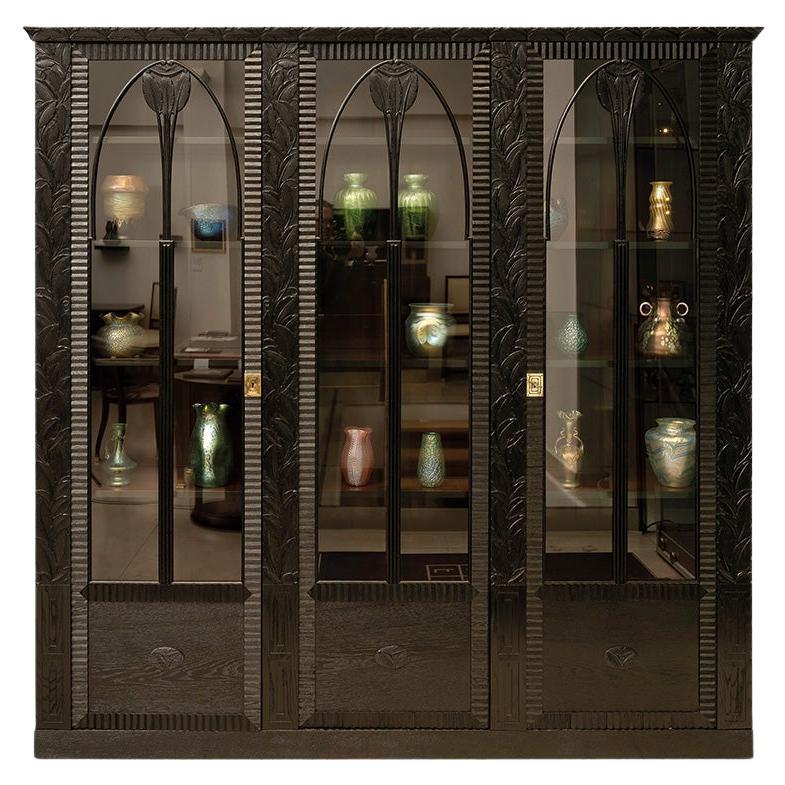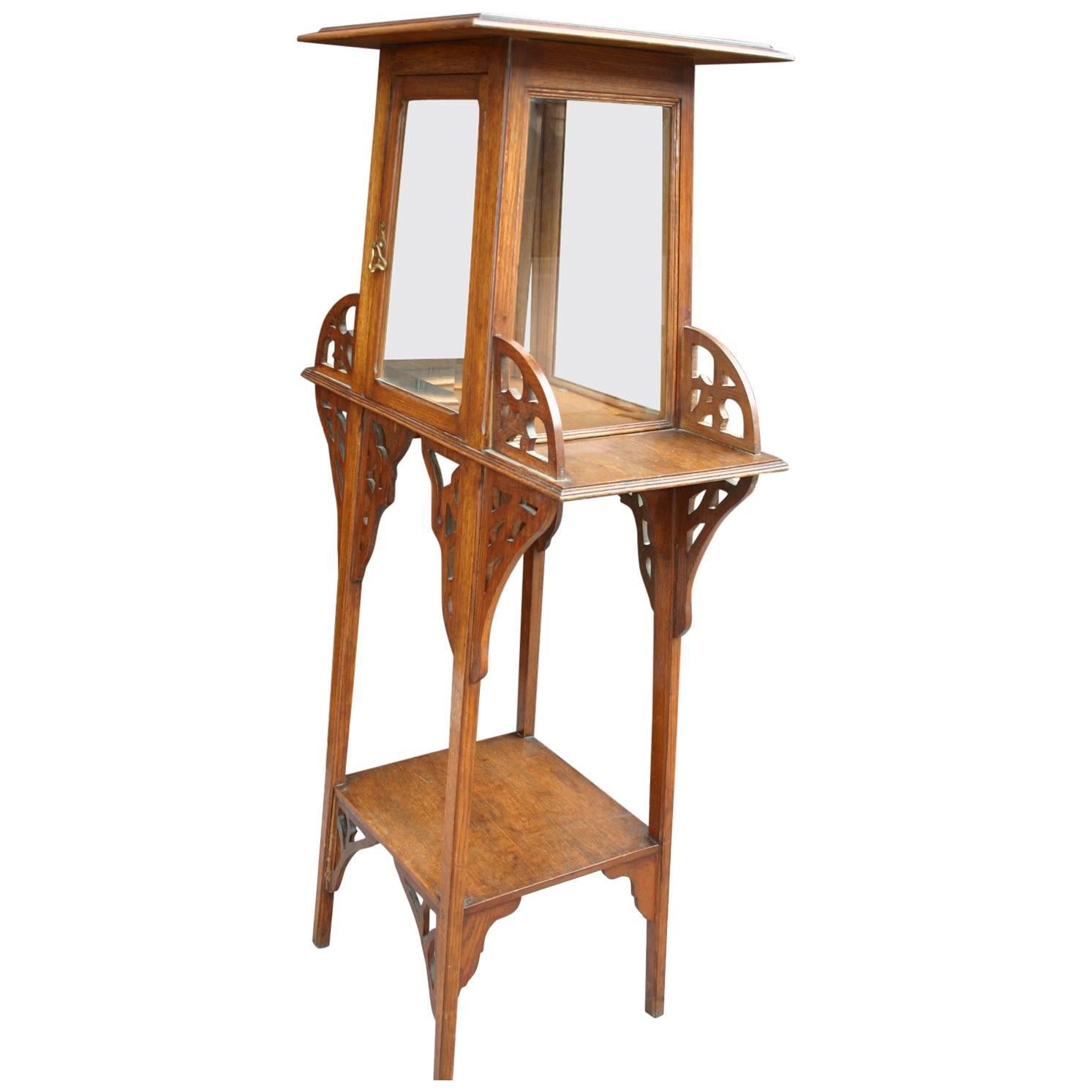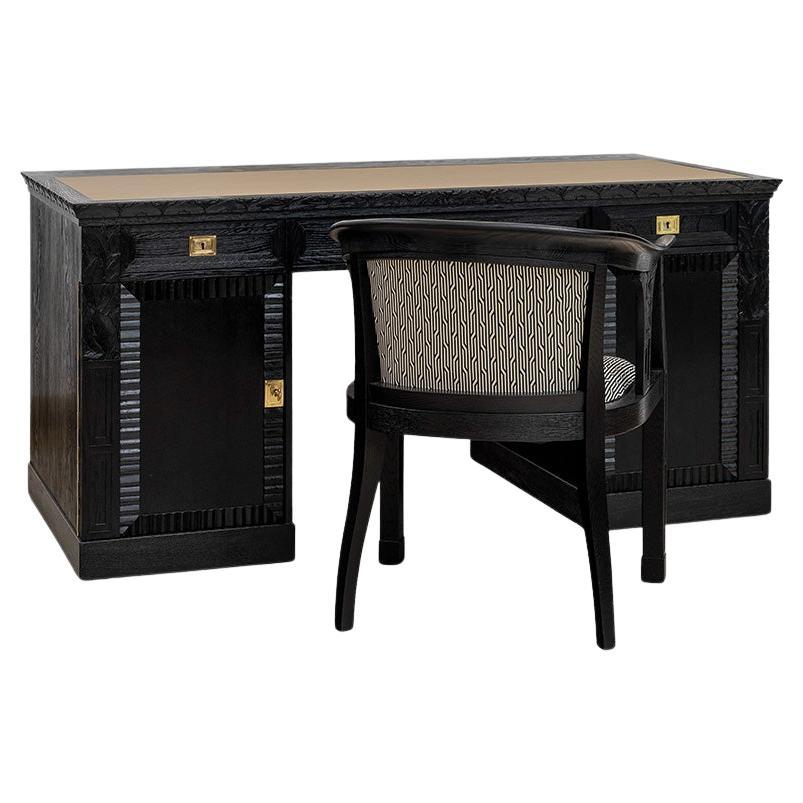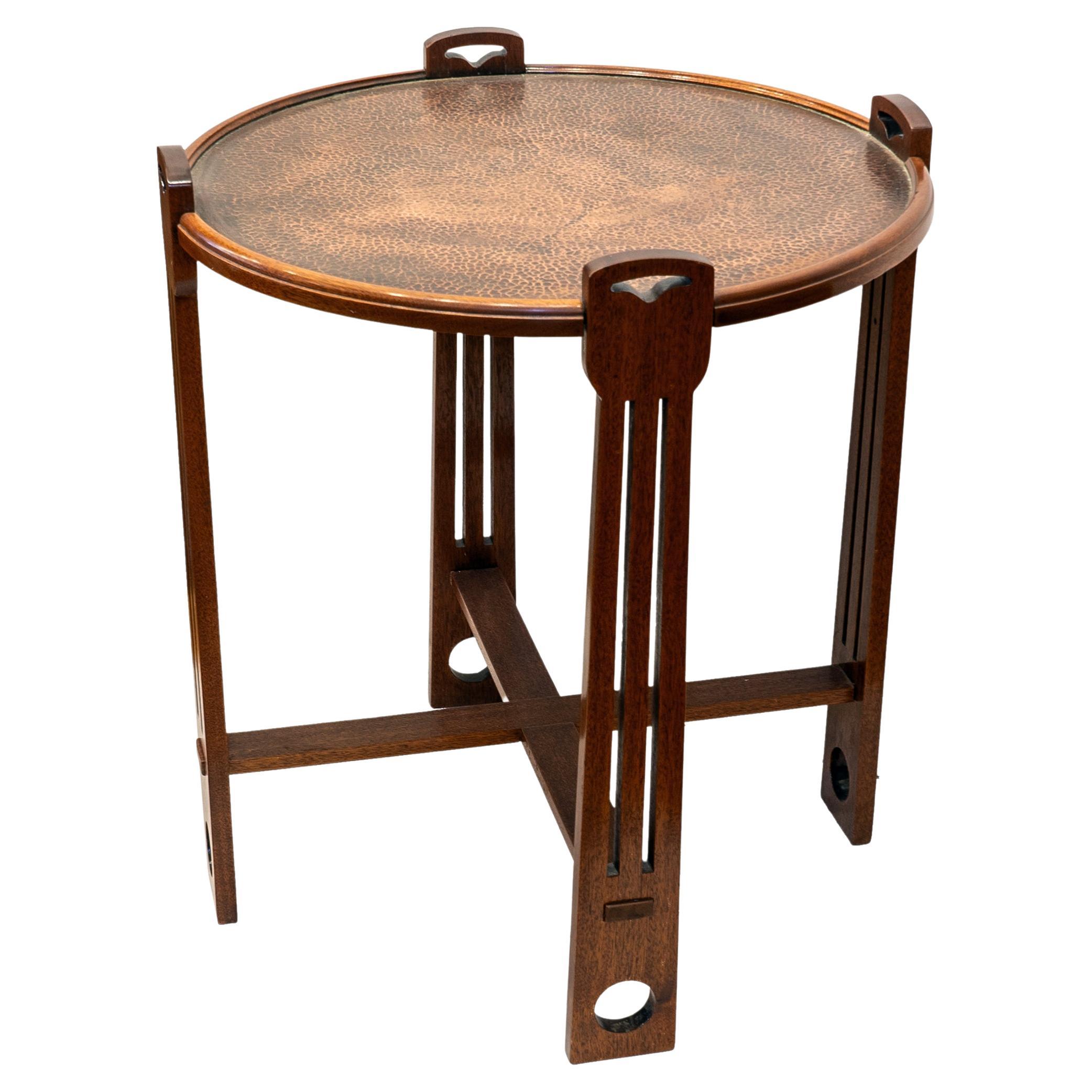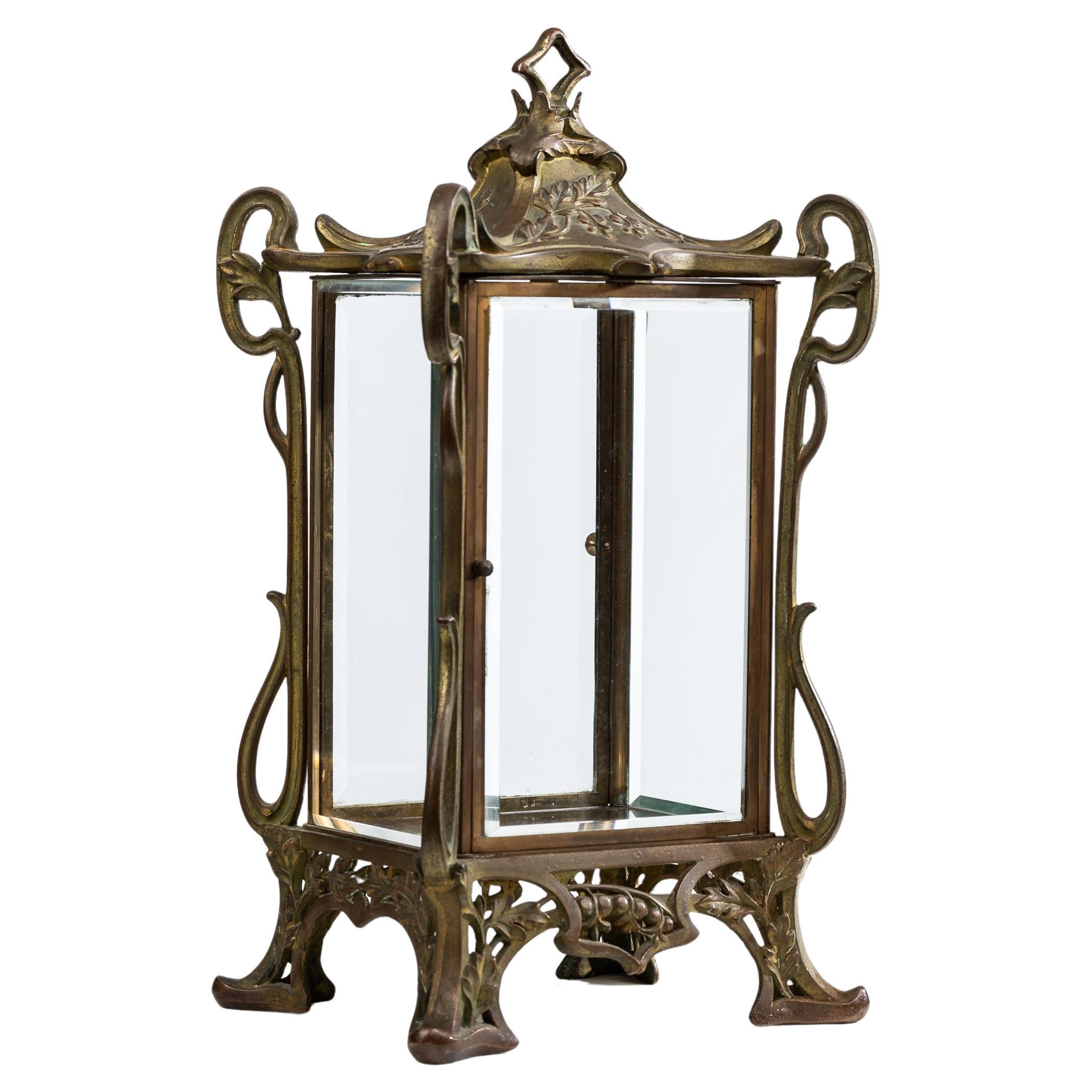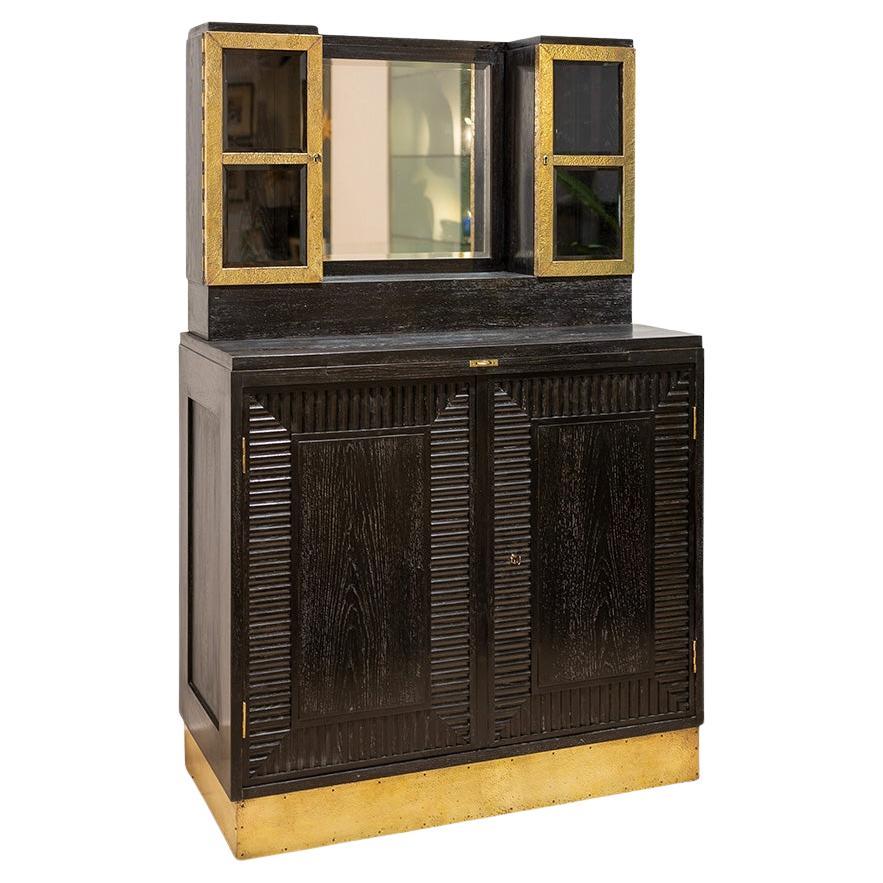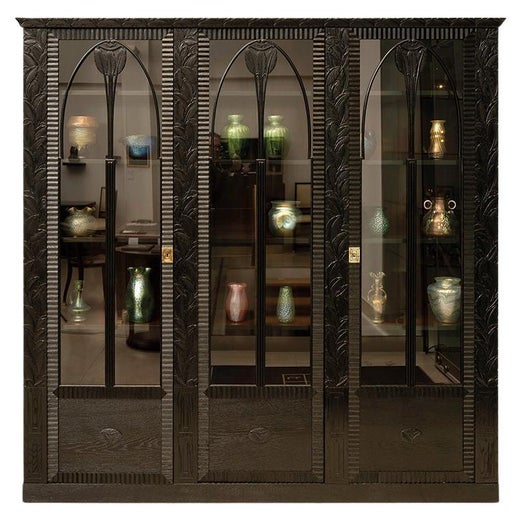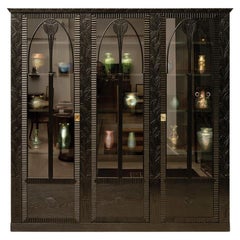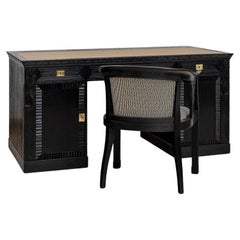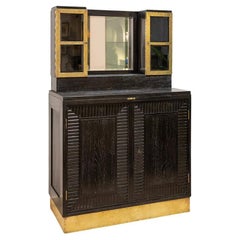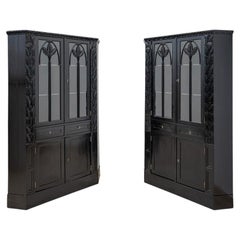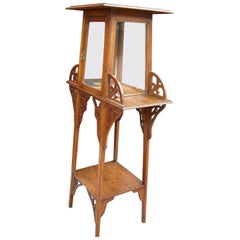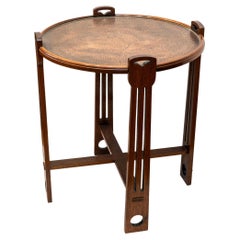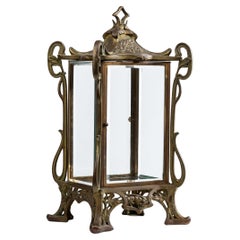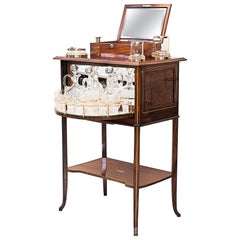Articoli simili a Viennese Art Nouveau showcase table Hans Bolek August Ungethüm 1913
Vuoi altre immagini o video?
Richiedi altre immagini o video al venditore
1 di 10
Viennese Art Nouveau showcase table Hans Bolek August Ungethüm 1913
40.250 €IVA inclusa
Informazioni sull’articolo
Technique: spruce; swamp oak veneer, stained and semi-matt polished
The furniture in this extraordinary study was designed in 1913 by Hans Bolek, an extremely talented student of the legendary Josef Hoffmann, and was impressively presented at the renowned Winter Exhibition of the Austrian Museum of Art and Industry (ÖMKI) in 1913/1914, together with a living room. The masterful craftsmanship was carried out by August Ungethüm, who was also trained under Hoffmann and was known for his excellent craftsmanship. International interior design magazines and daily newspapers praised the room at the time for its groundbreaking style and craftsmanship, which brought it attention and recognition far beyond Austria's borders. The entire study was purchased on November 6, 1913, by the then Minister of Public Works, Baron Ottokar Trnka von Laberon, further underscoring its high cultural and political value. Hans Bolek's work during his training period comprises only a few complete room furnishings, which makes this ensemble an exceptionally rare and art-historically significant testimony to Viennese Art Nouveau. The furniture is characterized by a clear, elegant design that was strongly influenced by Josef Hoffmann's style. Particularly noteworthy is the harmonious combination of strictly geometric forms with flowing floral elements— two seemingly contradictory styles that Bolek brought into aesthetic harmony with particular sensitivity and skill. This stylistic synthesis emphasizes the Viennese Art Nouveau's pursuit of a combination of aesthetic purity, decorative expressiveness, and functional clarity.
The ensemble consists of a representative desk with elegant fittings and a matching armchair made of solid oak, an impressive cabinet display case, and a stylish table display case or humidor. All pieces of furniture, except for the chair, are made of solid spruce wood and covered with high-quality swamp oak veneer. The surfaces have been carefully stained and finished with a silk matt shellac polish, giving them a subtle, elegant sheen. A special bonus is the existence of the original keys, which bear the company name “A. Ungethüm.” Particularly impressive is the cabinet display case, whose interior is lined with precious mahogany veneer, giving the display case a warm and deep aura. A historical photo of part of this ensemble is in the renowned collection of the Museum of Applied Arts (MAK) in Vienna and was published in various contemporary magazines during Bolek's lifetime. This unique group of furniture represents the spirit of late Viennese Art Nouveau in the highest quality and incomparable elegance and is exemplary of this period at the turn of the stylistic eras.
original key marked A. Ungethüm
Bibliography: Interior from the winter exhibition 1913-14 at MAK ; photograph of a room design by Hans Bolek, executed by August Ungethüm, Möbelfrabrik August Ungethüm, MAK Inv. nr. KI 7905-13 ; Innendekoration: mein Heim mein Stolz, Heft 25, 1914, S. 110 ; Kunst & Handwerk, Vol. 12, 1913, p. 629 ; Deutsches Volksblatt, 11. November 1913, S. 6 ; Neues Wiener Tagblatt, 22. November 1913, p. 33 ; yearly report 1913 ÖMKI, p. 4.
- Creatore:August Ungethüm Kunstmöbel-Fabrik (Ebanista),Hans Bolek (Designer)
- Dimensioni:Altezza: 117 cm (46,07 in)Larghezza: 69,5 cm (27,37 in)Profondità: 50 cm (19,69 in)
- Stile:Jugendstil (Del periodo)
- Materiali e tecniche:
- Luogo di origine:
- Periodo:1910-1919
- Data di produzione:1913
- Condizioni:Rifinito. Usura compatibile con l’età e l’utilizzo.
- Località del venditore:Klosterneuburg, AT
- Numero di riferimento:Venditore: 10871stDibs: LU5830246956282
Hans Bolek
Hans Bolek fu uno dei fondatori del cosiddetto Österreichischer Werkbund nel 1914. Lavorò insieme a Josef Hoffmann nel periodo 1939-41.
Informazioni sul venditore
5,0
Venditore professionale selezionato
Ogni venditore supera rigorosi standard di autenticità e affidabilità
Fondazione nel 2013
Venditore 1stDibs dal 2021
17 vendite su 1stDibs
- SpedizioneRecupero del preventivo…Spedizione da: Vienna, Austria
- Politica di reso
Alcune parti di questa pagina sono state tradotte automaticamente. 1stDibs non può garantire che le traduzioni siano corrette. L’inglese è la lingua predefinita del sito.
Garanzia di autenticità
Nell’improbabile caso in cui si verifichi un problema con l’autenticità di un articolo, contattaci entro un anno per ottenere un rimborso completo. DettagliGaranzia di rimborso
Se il tuo articolo non corrisponde alla descrizione, è danneggiato durante il trasporto o non arriva, contattaci entro 7 giorni per un rimborso completo. DettagliAnnullamento entro 24 ore
Hai un periodo di tolleranza di 24 ore per annullare il tuo acquisto, senza necessità di fornire spiegazioni.Venditori professionali selezionati
I nostri venditori di livello internazionale devono aderire a rigorosi standard di servizio e qualità, garantendo l’integrità delle inserzioni.Garanzia miglior prezzo
Se scopri che un venditore ha pubblicato altrove lo stesso articolo a un prezzo più basso, applicheremo lo stesso prezzo.Consegna globale affidabile
La nostra rete di vettori leader del settore offre opzioni di spedizione specializzate in tutto il mondo, inclusa la consegna personalizzata.Altro da questo venditore
Mostra tuttoGabinetto del libro Hans Bolek 1913
Di Hans Bolek, August Ungethüm Kunstmöbel-Fabrik
I mobili di questo straordinario studio sono stati progettati nel 1913 da Hans Bolek, un allievo di grande talento del leggendario Josef Hoffmann, e sono stati presentati in modo imp...
Categoria
Vintage, Anni 1910, Austriaco, Jugendstil, Arredi
Materiali
Mogano, Peccio
Viennese Art Nouveau desk with armchair Hans Bolek August Ungethüm 1913
Di Hans Bolek, August Ungethüm Kunstmöbel-Fabrik
technique:
desk: spruce body, swamp oak veneer, stained black and semi-matt polished; chair: solid swamp oak, stained black and semi-matt polished; new fabric upholstery
original k...
Categoria
Vintage, Anni 1910, Austriaco, Jugendstil, Scrivanie e scrittoi
Materiali
Peccio
Buffet Art Noveau di Fritz Nagel Scuola di Vienna di Josef Hoffmann 1910 ca.
Di Fritz Nagel
Questo piccolo buffet fa parte di un set per la sala da pranzo.
Piccolo buffet, Fritz Nagel (disegno), Adolf Nagel (esecuzione), scuola di Josef Hoffmann, 1910 ca.
Abete impiallacc...
Categoria
Vintage, Anni 1910, Austriaco, Jugendstil, Buffet
Materiali
Mogano, Peccio
Armadi ad angolo Hans Bolek attr. fine 1910
Di Hans Bolek
Queste due vetrine angolari mostrano perfettamente il design austriaco Art Noveau. Sono attribuiti a Hans Bolek, che ha studiato nella classe di architettura di Josef Hoffmann. Gli a...
Categoria
Inizio XX secolo, Austriaco, Jugendstil, Mobili contenitori
Materiali
Quercia
27.500 € / set
Armadio Art Nouveau viennese della scuola di Josef Hoffmann del 1900 ca.
Bib.: Das Interieur 1900, Tafel 19 / Innendekoration, Mein Heim mein Stolz, Vol 11, 1900, p. 127 / Dekorative Kunst - Illustrierte Zeitschrift für angewandte Kunst, Vol 6, 1900, p. 4...
Categoria
Inizio XX secolo, Austriaco, Art Nouveau, Buffet
Materiali
Ottone
Art Nouveau desk by Matthias Feller manufactured by M. Ballin München ca. 1912
Desk, Matthias Feller (design), M. Ballin München (manufacturer), ca. 1912
marked twice with "M. Ballin München"; bib.: "Innendekoration - mein Heim, mein Stolz", 1912, S. 200.
tec...
Categoria
Vintage, Anni 1910, Austriaco, Jugendstil, Scrivanie e scrittoi
Materiali
Noce
Ti potrebbe interessare anche
Raro tavolo/supporto in stile Jugendstil o Art Nouveau con vetrinetta
Elegante e pratico tavolo in stile Liberty con vetrina incorporata.
Questo mobile Art Nouveau multistrato e multiuso è un ottimo esempio dei design creativi ed eleganti realizzati a...
Categoria
Inizio XX secolo, Europeo, Art Nouveau, Vetrine
Materiali
Vetro, Legno
Tavolo da fumo Jugendstil, Svezia 1900
Questo bellissimo tavolo può essere utilizzato quotidianamente ed è solido e durevole grazie alla superficie in rame martellato e alla solida falegnameria. Chiaramente influenzato da...
Categoria
Di antiquariato/d’epoca, Inizio Novecento, Svedese, Jugendstil, Tavoli
Materiali
Rame
Spettacolare tavolo a vetri in bronzo massiccio, ottone Jugendstil Art Nouveau 1900 Francia
Questa vetrina da tavolo incredibilmente bella è un originale del periodo Art Nouveau in Francia nel 1900.
La qualità eccezionalmente alta della vetrina si riflette nella lavorazio...
Categoria
Di antiquariato/d’epoca, Inizio Novecento, Francese, Art Nouveau, Vetrine
Materiali
Ottone, Bronzo
2900 € Prezzo promozionale
20% in meno
Bellissimo e raro tavolo da bar in stile Art Nouveau con un set da fumo completo
Bar e set da fumo in stile Art Nouveau.
Lucidato e smaltato a fuoco
sul lato superiore c'è la scatola dei sigari.
Si apre premendo un pulsante sul lato destro.
Tre bottiglie oval...
Categoria
Di antiquariato/d’epoca, Inizio Novecento, Austriaco, Jugendstil, Mobili...
Materiali
Ottone
Libreria/armadio originale del tempo con marchio "Wiener Werkstätte" Koloman Moser
Di Wiener Werkstätte, Koloman Moser, Woka Lamps
Rarissimo mobile risalente al breve periodo in cui la Wiener Werkstätte aveva un proprio laboratorio di ebanisteria nella Neustiftgasse di Vienna. Attribuito a Koloman Moser o Emanue...
Categoria
Inizio XX secolo, Austriaco, Jugendstil, Vetrine
Materiali
Quercia
168.000 €
Spedizione gratuita
Armadio originale di Josef Hoffmann e Wiener Werkstätte per Mimi Marlow del XX secolo
Di Josef Hoffmann, Wiener Werkstätte
Per il salone privato dell'allora famosa soubrette Mimi Marlow, che si esibiva anche nel leggendario "Cabaret Fledermaus", progettato da Josef Hoffmann e realizzato dalla Wiener Werk...
Categoria
Vintage, Anni 1910, Austriaco, Jugendstil, Mobili contenitori
Materiali
Quercia
38.400 €
Spedizione gratuita
